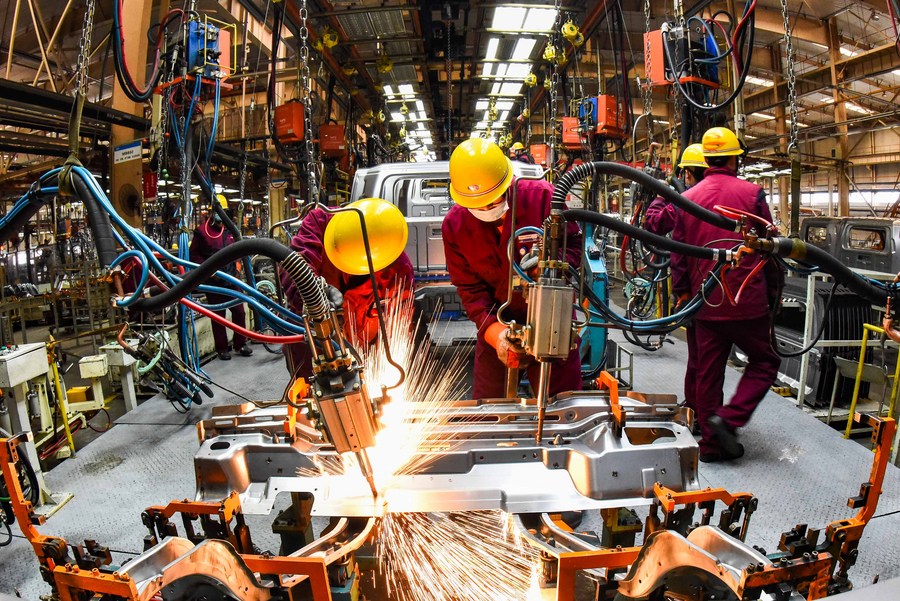How will China's manufacturing fare in next five years?
China has set strategic goals to develop into a manufacturing powerhouse from 2021 to 2025, forging ahead on greater innovation and vitality, said the Ministry of Industry and Information Technology (MIIT).
China has set strategic goals to develop into a manufacturing powerhouse from 2021 to 2025, forging ahead on greater innovation and vitality, said the Ministry of Industry and Information Technology (MIIT).

Workers weld components at a workshop of an automobile manufacturing enterprise in Qingzhou City, east China's Shandong Province, Feb. 28, 2021. (Photo by Wang Jilin/Xinhua)
Boasting the world's most comprehensive industrial system with more quality and high-end products churned out by Chinese manufacturers, the transition from "made in China" to "designed in China" is kicking into high gear.
China would speed up its new industrialization and informatization process, MIIT minister Xiao Yaqing told a press conference Monday. Xiao pledged that the country would develop into a "manufacturing powerhouse" and "network powerhouse" through five-year efforts.
The ministry is paying close attention to the top-level design, Xiao said, adding that it is formulating the 14th five-year development plans for different industries. These plans will be released over the next four months.
COMPETITIVENESS
The country's manufacturing sector has topped the world for 11 consecutive years since 2010, Xiao said, hailing that the country's position as a manufacturing country has further strengthened.
The added industrial value of the Chinese manufacturing sector grew from 16.98 trillion yuan (about 2.63 trillion U.S. dollars) in 2012 to 26.6 trillion yuan in 2020. The figure gives Chinese manufacturers a 30-percent-share of the global total-added industrial value.
China also boasts the world's most comprehensive industrial system with 41 major industrial categories. More than 40 percent of the outputs of Chinese-manufactured products rank the top of the world among 500 major industrial goods.
In the meantime, more and more key industries, including new energy vehicles (NEVs) and photovoltaic equipment, lead the world with high-end brands such as telecommunication devices going into the global playing field.
INDUSTRIAL UPGRADE
Stressing 5-year-period industrial upgrades and optimization at the press briefing, Xiao said the ministry would improve the manufacturing sector level and implement the carbon neutrality and carbon peak goals.
Notable breakthroughs would happen in the key sectors focusing on new-generation information technology, new energy, and high-end equipment, Tian Yulong, chief engineer from the MIIT, told the press briefing. Tian noted that these sectors are closely related to the core industry competitiveness.
In traditional industries such as engineering, building materials, and chemical sectors, efforts would promote technology levels and build the industrial chain more solidly, Tian said.
As for the overall industrial sector, Xiao said the low-carbon transition would conclude in the next five years. "It is an arduous task for the industrial sector to achieve the carbon goals, but also a significant opportunity," the minister told the press briefing.
During recent years, under the country's emissions-cutting initiative, the market share of China's solar cell module represents more than 70 percent of the global total. By the end of August, the sales of China's NEVs exceeded seven million, accounting for about half the total globally and topping the world ranking.
The ministry would speed up efforts to lower emission intensity and will likely see a faster pace in the industrial structure adjustment by key industries, Xiao said. Xiao added that it is formulating the green development plan for the industrial sector during the 14th Five-Year period (2021-2025) and will release it soon.
DIGITAL ECONOMY
Noting the digitalization trend in the global economy, Xiao said that the manufacturing businesses going digital is the "compulsory course" for the sector's development and vowed efforts to promote digital transformation throughout the entire sector and develop 5G networks.
Currently, the development momentum of the digital economy is still robust, with new business forms and new models emerging. It would provide strong growth support for the manufacturing industry, Xiao said.
Looking to the future, key technology breakthroughs in sectors such as high-end chips and basic software, and planning of front-tier technology such as quantum information and advanced computing, would strengthen.
Meanwhile, the construction of new forms of digital infrastructure and the cultivation of emerging industries such as artificial intelligence, big data, and cloud computing would move faster, said the minister.
Hailing the faster growth of the country's 5G industry, Zhao Zhiguo, director of the cybersecurity management bureau from the MIIT, said the shipments of 5G equipment of local brands and chip-design capability in China boast leading advantages globally.
Talking about the future focuses on 5G, Zhao said the ministry would expand application scenarios facing three key sectors, including new information consumption forms, the real economy, and public services.
The number of 5G terminal connections in China now stands at above 400 million, ranking first worldwide. Its 5G base stations make up over 70 percent of the global total. China's 5G development has made positive progress, Xiao said.

